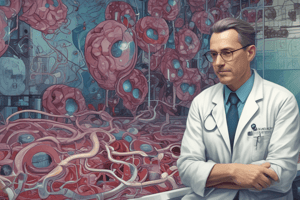Podcast
Questions and Answers
What does etiology of disease refer to?
What does etiology of disease refer to?
- The spread of a disease
- The cause of a disease (correct)
- Symptoms related to a disease
- Treatment methods for diseases
Which of the following describes predisposing causes of disease?
Which of the following describes predisposing causes of disease?
- Environmental factors affecting health
- Directly responsible agents causing disease
- Results of disease progression
- Factors making individuals more susceptible to disease (correct)
What is the primary focus of pathogenesis?
What is the primary focus of pathogenesis?
- Identification of disease complications
- Treatment outcomes of different diseases
- The mechanisms by which disease occurs (correct)
- The study of the gross features of disease
Which of the following is included in the gross morphological features of a disease?
Which of the following is included in the gross morphological features of a disease?
What constitutes a good prognosis in terms of disease outcomes?
What constitutes a good prognosis in terms of disease outcomes?
Which of the following best defines complications of a disease?
Which of the following best defines complications of a disease?
Which technique is used to examine the microscopic picture of tissue?
Which technique is used to examine the microscopic picture of tissue?
What is the definition of pathology?
What is the definition of pathology?
Which classification of pathology focuses on general reactions of cells and tissues to injuries?
Which classification of pathology focuses on general reactions of cells and tissues to injuries?
What is necropsy pathology primarily concerned with?
What is necropsy pathology primarily concerned with?
Which biopsy method is specifically the excision of the entire mass?
Which biopsy method is specifically the excision of the entire mass?
Which type of pathology examines the structural and functional changes in tissues caused by irritants?
Which type of pathology examines the structural and functional changes in tissues caused by irritants?
What is the primary method of obtaining cells for cytopathology?
What is the primary method of obtaining cells for cytopathology?
Which item is NOT included in the study of any disease?
Which item is NOT included in the study of any disease?
What type of disease is caused by chromosomal abnormalities or gene mutations?
What type of disease is caused by chromosomal abnormalities or gene mutations?
Flashcards
Etiology of Disease
Etiology of Disease
The cause of a disease
Predisposing Cause
Predisposing Cause
Factors making one more likely to get a disease
Exciting Cause
Exciting Cause
Direct cause of a disease, often an infection
Pathogenesis
Pathogenesis
Signup and view all the flashcards
Morphological Features
Morphological Features
Signup and view all the flashcards
Complications
Complications
Signup and view all the flashcards
Prognosis
Prognosis
Signup and view all the flashcards
Pathology Definition
Pathology Definition
Signup and view all the flashcards
General Pathology
General Pathology
Signup and view all the flashcards
Systemic Pathology
Systemic Pathology
Signup and view all the flashcards
Necropsy Pathology (Autopsy)
Necropsy Pathology (Autopsy)
Signup and view all the flashcards
Surgical Pathology (Biopsy)
Surgical Pathology (Biopsy)
Signup and view all the flashcards
Types of Biopsies
Types of Biopsies
Signup and view all the flashcards
Histopathology
Histopathology
Signup and view all the flashcards
Cytopathology (FNAC)
Cytopathology (FNAC)
Signup and view all the flashcards
Study Notes
Introduction to Pathology
- Pathology is the science that studies the nature of disease.
- Pathology classifications include general and systemic pathology.
- General pathology studies the fundamental responses of cells and tissues to injury in all disease processes.
- Systemic pathology focuses on specific disease processes affecting particular organs or organ systems (e.g., cardiovascular system, central nervous system, gastrointestinal tract).
Applied Pathology Classification
- Necropsy pathology examines tissues from deceased individuals to determine the cause of death; this is called "autopsy."
- Surgical pathology examines tissues from living patients to establish a specific diagnosis; this is called "biopsy."
Biopsy Methods
- Needle or core biopsy: A needle is inserted into a mass to collect a tissue sample. This method may not yield enough material for analysis.
- Incisional biopsy: A larger tissue sample is collected using an incision.
- Excisional biopsy: The entire mass is removed for analysis.
Classification of Pathology by Specimen Type
- Histopathology: Examination of tissues for diagnosis.
- Cytopathology: Microscopic study of exfoliated cells from body fluids.
Fine Needle Aspiration Cytology (FNAC)
- FNAC is a technique using a thin needle to obtain cells from a mass for cytological analysis.
- It is used for both superficial and deep-seated masses (with guidance from radiology).
The Disease
- Disease involves structural and functional changes within organs and tissues caused by an irritant or causative agent.
Classification of Diseases
- Hereditary diseases arise from chromosomal abnormalities or gene mutations.
- Acquired diseases include inflammatory conditions, neoplasms (tumors), degenerative conditions (like aging), and metabolic disorders.
Items of Study for Diseases
- Definition
- Etiology (cause)
- Pathogenesis (mechanism)
- Morphological features (observable characteristics)
- Complications
- Prognosis (expected outcome)
Etiology of a Disease (Cause of Disease)
- Predisposing causes: Factors that make a person more prone to a disease (e.g., heredity, low immunity)
- Exciting causes: Factors directly responsible for the disease (e.g., infection)
Pathogenesis of a Disease (Mechanism)
- Describes how an etiologic agent causes the disease.
Morphology of a Disease
- Gross picture: Examination of the tissue by the naked eye (size, shape, color, consistency, cut section).
- Microscopic picture: Examination of tissue sections under a microscope. This is used to determine the nature of a disease.
Complications of a Disease
- Pathological changes that occur after the initial disease course has run its usual course.
- Examples include a cold progressing to bronchitis, or bronchitis progressing to pneumonia.
Prognosis of a Disease
- The expected outcome or fate of the disease, which may be good or poor, suggesting either likely recovery or potential disability or death.
References
- Robbins and Cotran Pathologic Basis of Disease, 9th edition, 2014 (Kumar, Abbas, Aster)
- Robbins Basic Pathology 10th edition, 2017 (Kumar, Abbas, Aster)
Studying That Suits You
Use AI to generate personalized quizzes and flashcards to suit your learning preferences.




